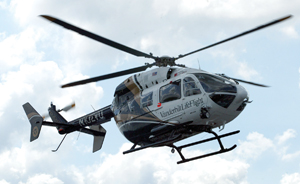
LifeFlight is helping to quickly get heart patients from outlying counties to Vanderbilt. (photo by Neil Brake)
Rapid response program’s success buys time for area cardiac patients
Since its inception a year ago, the STEMI Network has played a critical role in saving the lives of heart attack victims in outlying communities.
In December, two Hickman County residents were the beneficiaries of the rapid response program activated by the local EMS and Vanderbilt LifeFlight nurses.
STEMI is an acronym for ST segment elevation myocardial infarction, a heart attack caused by a blocked coronary artery.
Douglas Canady, 70, was in relatively good health until he started feeling lightheaded and dizzy while working outside on Dec. 11.
He broke into a cold sweat, went inside and lay down on the floor. His stepdaughter called the Hickman County EMS.
When paramedics arrived, they saw evidence of a STEMI and contacted LifeFlight for transfer to Vanderbilt University Medical Center.
The flight nurses, Kevin Nooner, R.N., and Bob Anderson, R.N., activated the STEMI network, which means they called Vanderbilt and told them to prepare the cardiac cath lab for Canady.
The gold standard for treating a STEMI is to use a tiny balloon to open up the artery and then insert a stent. The procedure is performed in the catheterization lab and is highly effective — if it is done in time.
By activating the STEMI network, Canady could bypass a stop in the ER, saving critical minutes and heart muscle.
Once Canady arrived in the cath lab at Vanderbilt, the cardiologist discovered that he had critical blockage in two of the three blood vessels of the heart. Both were successfully opened with stents.
“What makes this case so very unique is that the patient went from home to the Vanderbilt cath lab without even having to go to an ER,” said Vanderbilt interventional cardiologist Joseph Fredi, M.D., assistant professor of Medicine.
“In Mr. Canady's case, had that not happened he may not have been a survivor. This is an example of the system working at its very best.”
Ronald Batts, 58, of Lyles, was polishing his antique John Deere tractor on Dec. 23 when he experienced sudden chest pain, shortness of breath and broke into a cold sweat.
“The pain was like a knife. I've never had pain like that before,” Batts said.
His friend called 911, and paramedics arrived at his home and determined that LifeFlight was the quickest way to transport him.
The flight nurses, Michele Minnich, R.N., and Amy Moore, R.N., determined that Batts was having a heart attack, so they activated the STEMI network.
LifeFlight landed atop Vanderbilt University Hospital, and Batts was transported to the cath lab, where a physician discovered he had a 90 percent blockage in his coronary artery, which was successfully opened with two stents.
Fredi said Vanderbilt's trust in the Hickman County EMS system and LifeFlight nurses to activate the cath lab when they deemed necessary points out the success of the process as Vanderbilt designed it.
“I don't think this could have happened anywhere else in Nashville,” Fredi said.













